A Study on the Estimations of the Tension of the Overhead Wires Using Data from Acceleration Sensors
Abstract
:1. Introduction
2. Related Works
3. Estimation of the Tension of the Overhead Wires
3.1. Theoretical Background of Estimating Tension of the Overhead Wires
3.2. Experimental Operation and Condition
3.2.1. Acceleration Sensor Installation Environment
3.2.2. Experimental Operation and Condition
3.3. Measured Data and Pre-Processing
3.3.1. Example of the Measured Data
3.3.2. Data Normalization
3.3.3. Data Conversion
3.4. Analysis of the Similarity of the Data
3.5. Deduction of the Formulations for Estimated Tension of the Overhead Wires
4. Verifications of Proposed Method
4.1. Verifications of Normalized Patterns for the Tension of the Overhead Wires
4.2. Conversion of the Tension and Verifications of Tension Value of the Overhead Wires
5. Conclusions
Author Contributions
Funding
Institutional Review Board Statement
Informed Consent Statement
Data Availability Statement
Conflicts of Interest
References
- DS-3300; Distribution System Design Standard. KEPCO: Naju-si, Korea, 2022.
- Zhang, S.; Zhou, J.; Zhou, Y.; Zhang, H.; Chen, J. Cable Tension Monitoring Based on the Elasto-Magnetic Effect and the Self-Induction Phenomenon. Materials 2019, 12, 2230. [Google Scholar] [CrossRef] [PubMed] [Green Version]
- Jasman, N.A.; Normisyidi, N.A.L.; Hoe, Y.S.; Zainal Abidin, A.R.; Mohd Haniffah, M.R. Numerical Calculation of Two-Dimensional Subsea Cable Tension Problem Using Minimization Approach. MATEMATIKA Malays. J. Ind. Appl. Math. 2019, 35, 15–32. [Google Scholar] [CrossRef]
- Fang, Z.; Wang, J. Practical Formula for Cable Tension Estimation by Vibration Method. J. Bridge Eng. 2012, 17, 161–164. [Google Scholar] [CrossRef]
- Zui, H.; Shinke, T.; Namita, Y. Practical Formulas for Estimation of Cable Tension by Vibration Method. J. Struct. Eng. 1996, 122, 651–656. [Google Scholar] [CrossRef]
- Kim, B.H.; Park, T.H. Estimation of cable tension force using the frequency-based system identification method. J. Sound Vib. 2007, 304, 660–676. [Google Scholar] [CrossRef]
- Ren, W.-X.; Chen, G.; Hu, W.H. Empirical formulas to estimate cable tension by cable fundamental frequency. Struct. Eng. Mech. 2005, 20, 363–380. [Google Scholar] [CrossRef]
- Feng, D.; Scarangello, T.; Feng, M.Q.; Ye, Q. Cable tension force estimate using novel noncontact vision-based sensor. Measurement 2017, 99, 44–52. [Google Scholar] [CrossRef]
- Jeong, S.; Kim, H.; Lee, J.; Sim, S.-H. Automated wireless monitoring system for cable tension forces using deep learning. Struct. Health Monit. 2021, 20, 1805–1821. [Google Scholar] [CrossRef]
- Jana, D.; Nagarajaiah, S. Computer vision-based real-time cable tension estimation in Dubrovnik cable-stayed bridge using moving handheld video camera. Struct. Control. Health Monit. 2021, 28, e2713. [Google Scholar] [CrossRef]
- Jana, D.; Nagarajaiah, S.; Yang, Y.; Li, S. Real-time cable tension estimation from acceleration measurements using wireless sensors with packet data losses: Analytics with compressive sensing and sparse component analysis. J. Civ. Struct. Health Monit. 2021, 1–19. [Google Scholar] [CrossRef]
- Matsumiya, H.; Taruishi, S.; Shimizu, M.; Sakaguchi, G. Equivalent Static Wind Loads on Snow-accreted Overhead Wires. Struct. Eng. Int. 2022, 32, 78–91. [Google Scholar] [CrossRef]
- Derosa, S.; Nåvik, P.; Collina, A.; Rønnquist, A. Railway catenary tension force monitoring via the analysis of wave propagation in cables. J. Rail Rapid Transit 2020, 235, 494–504. [Google Scholar] [CrossRef]
- He, F.; Guo, D.; Chen, L. Numerical study of contact wire tension affecting dropper stress of a catenary system. Adv. Mech. Eng. 2021, 13, 1687814021995041. [Google Scholar] [CrossRef]
- R Wavelets User Manual: Functions for Computing Wavelet Filters, Wavelet Transforms and Multiresolution Analyses. Eric Aldrich. 2020. Available online: https://cran.r-project.org/web/packages/wavelets/wavelets.pdf (accessed on 11 July 2022).
- Borivoje, F. Encyclopedia of Multimedia; Springer: New York, NY, USA, 2006. [Google Scholar]


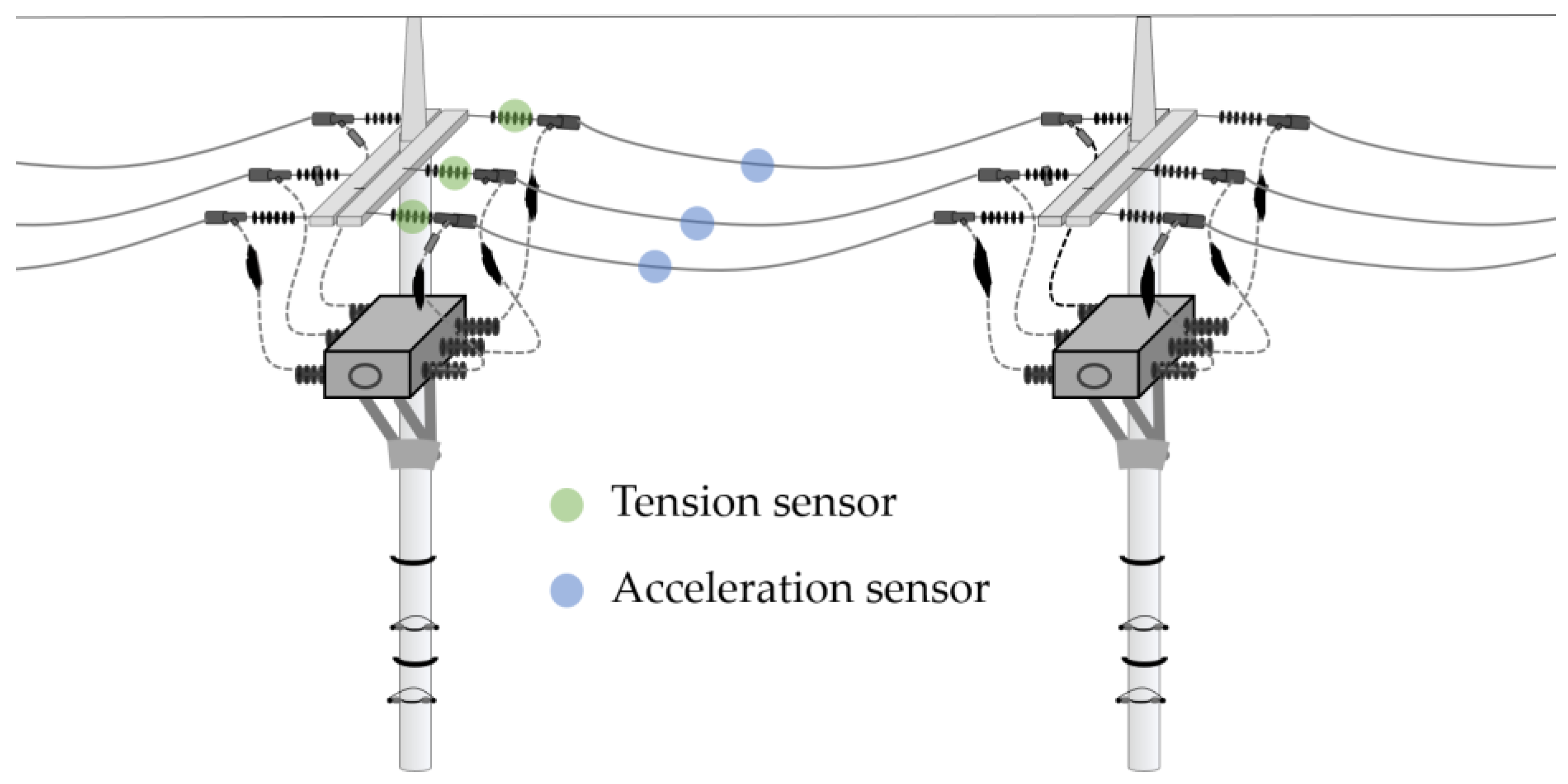
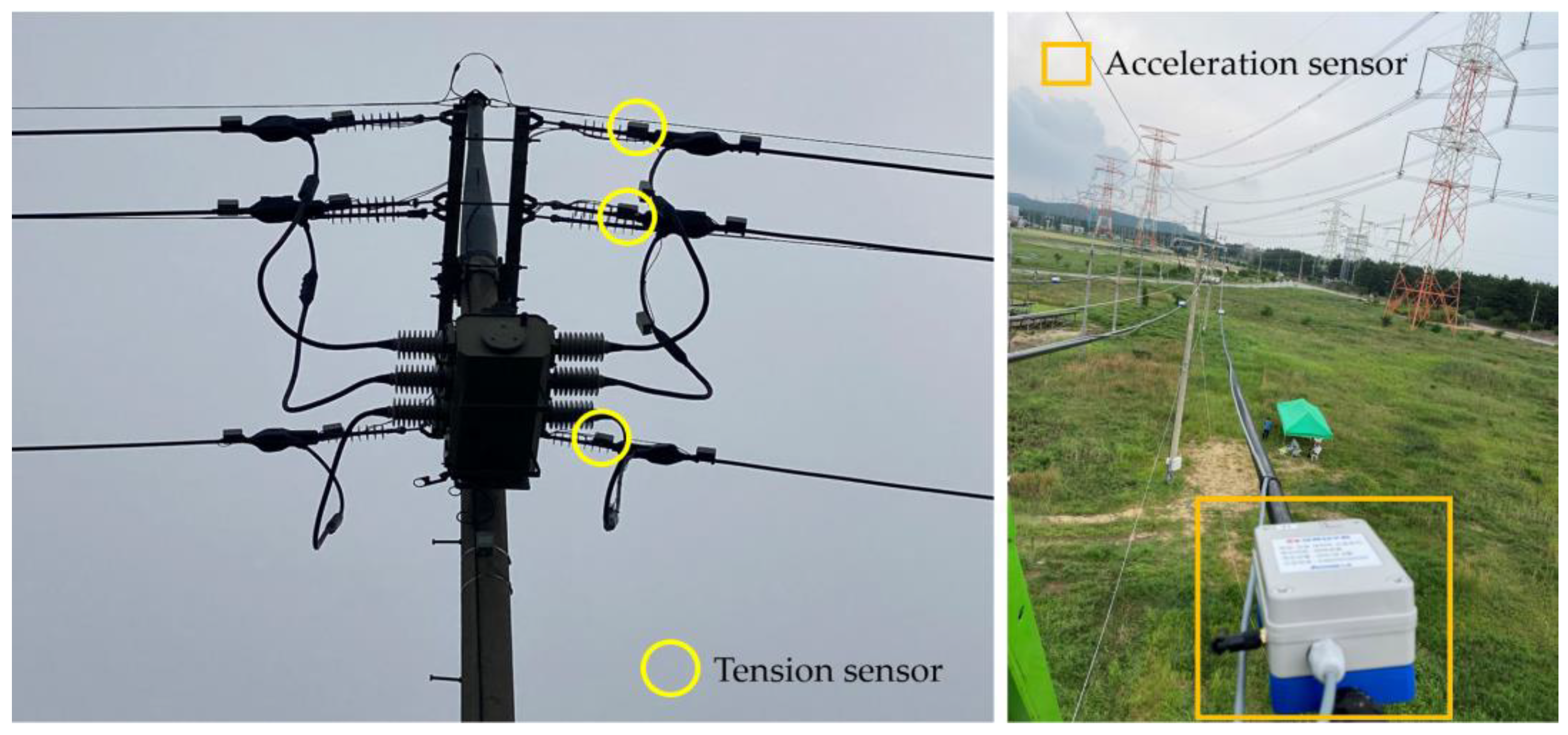

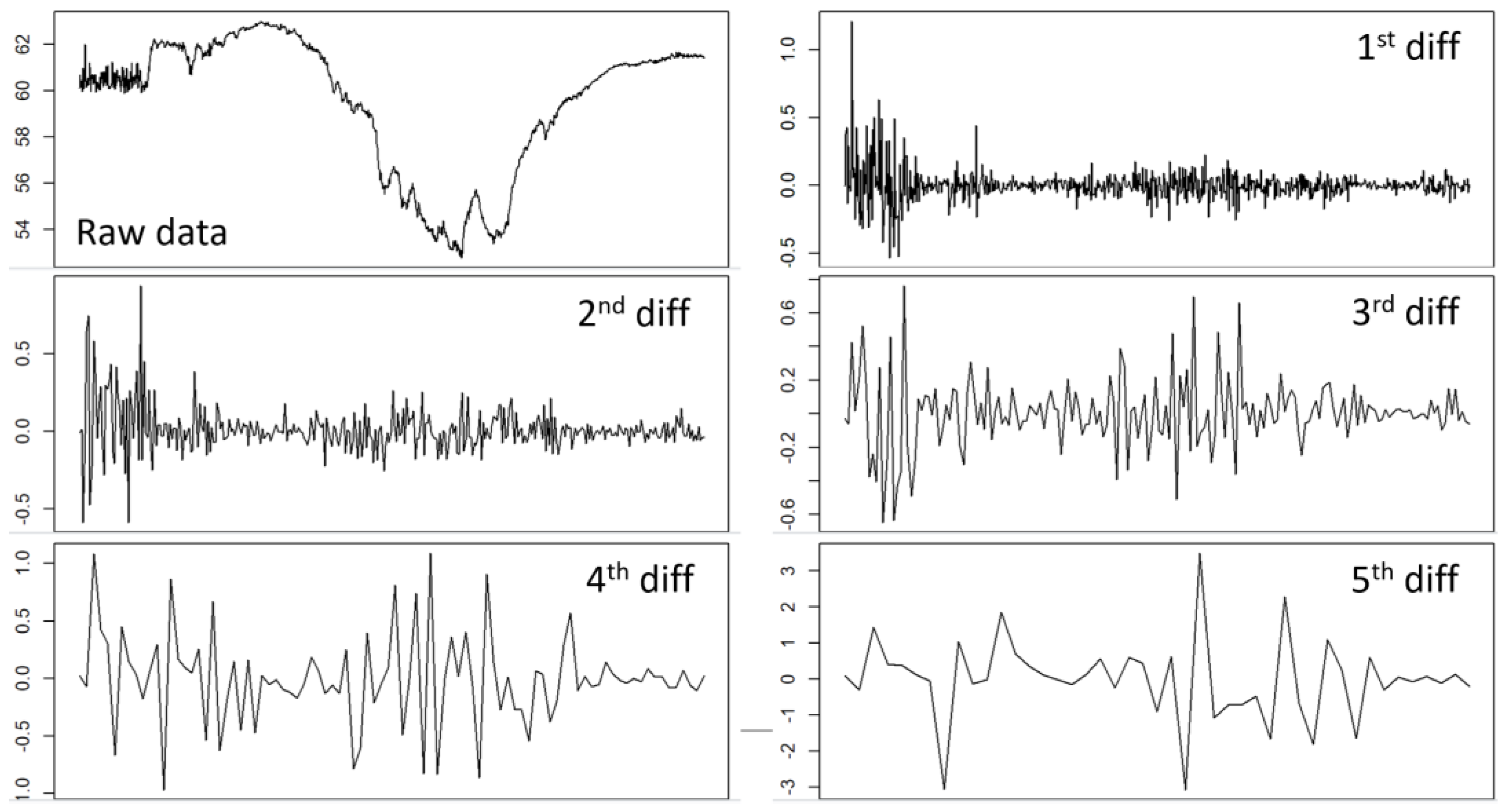
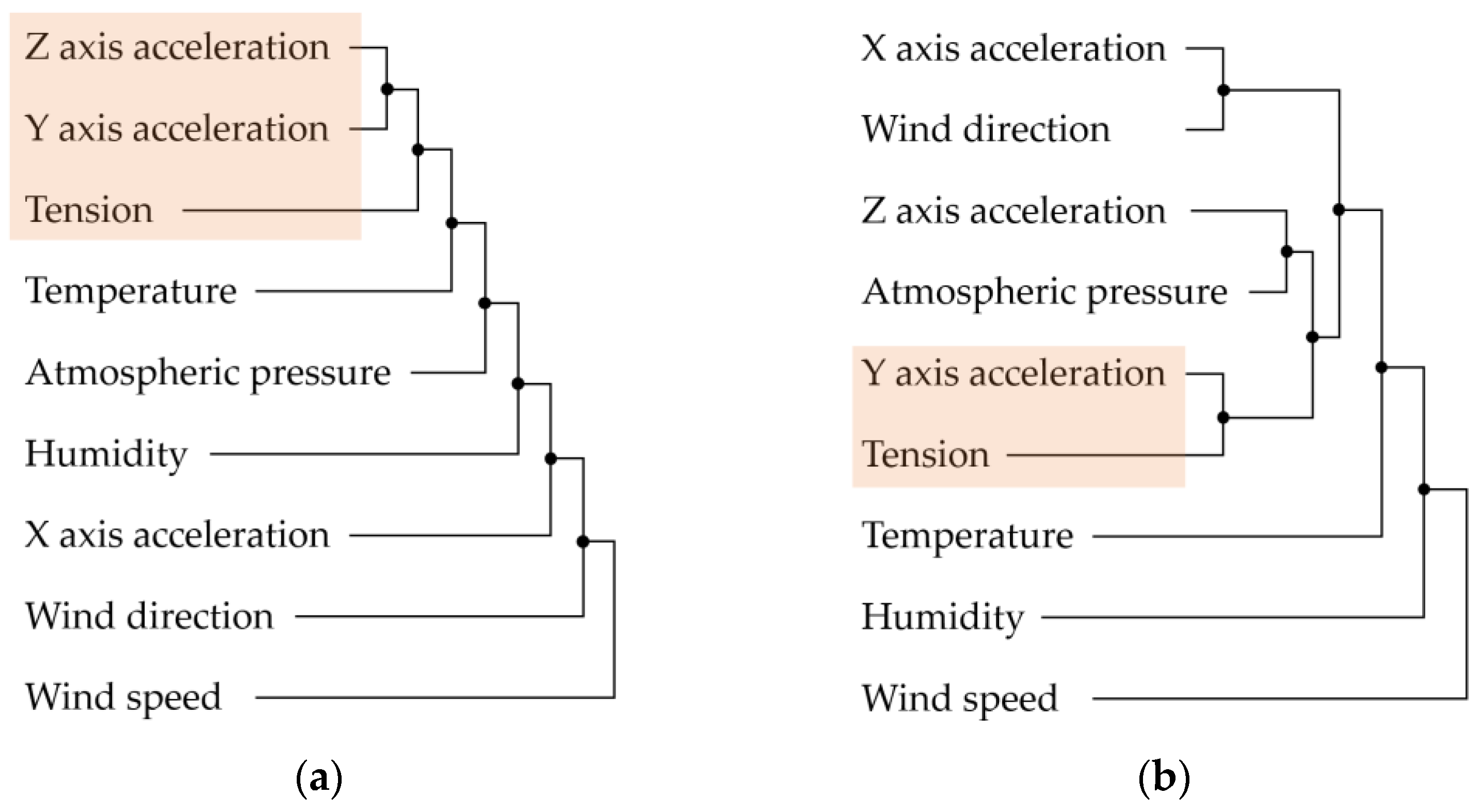
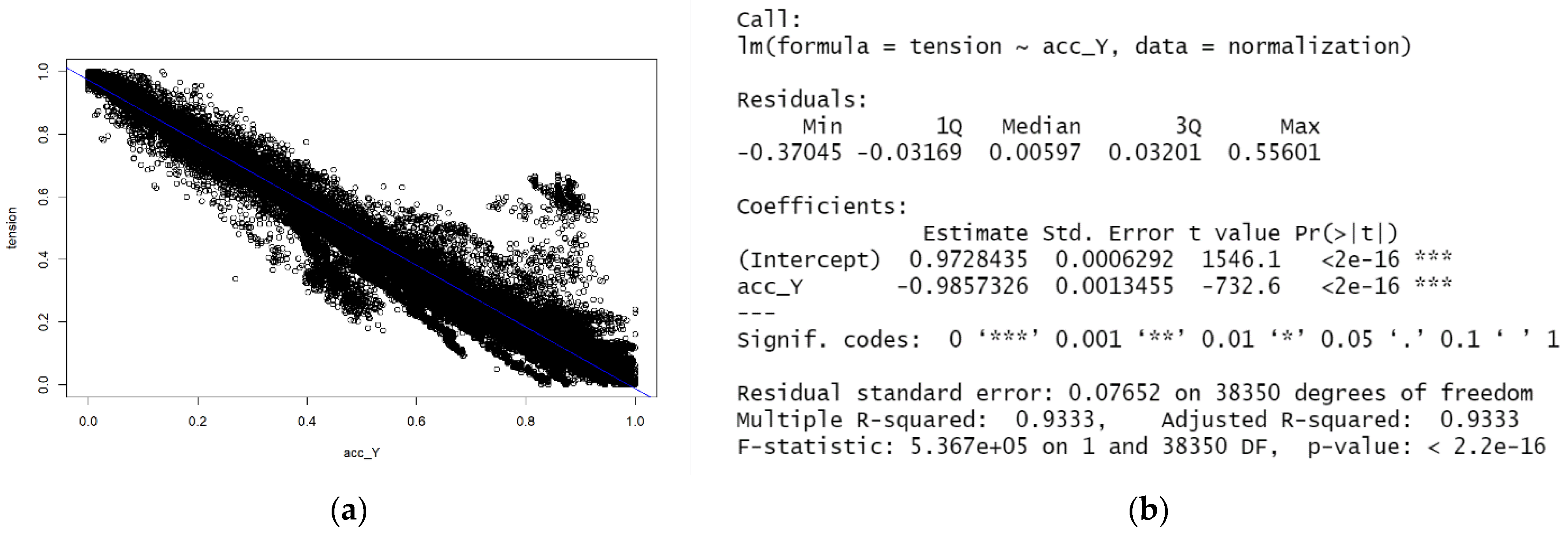

| Fundamentals of Calculation for Dip |
|---|
| The tension of the wires shall be set so that the wire tension (estimated maximum tension) when the worst condition is expected to be applied to the wire under the prescribed applied wind load is less than the allowable maximum tension of the wire. This calculation is based on the following equation: |
| : allowable tension (kg); |
| : tensile load on the wire (kg); |
| : safety margin |
| Here, the allowable tension of the wire when the safety margin is set to the minimum (Fmin) is called the allowable maximum tension. |
| Tension | Wind Speed | Wind Direction | Temperature | Humidity | Atmospheric Pressure | Acc_X | Acc_Y | Acc_Z | |
|---|---|---|---|---|---|---|---|---|---|
| Tension | 1.00 | 0.23 | −0.04 | −0.38 | 0.08 | 0.03 | 0.06 | −0.74 | −0.21 |
| Wind speed | 0.23 | 1.00 | −0.05 | 0.06 | −0.30 | −0.10 | 0.03 | −0.20 | 0.10 |
| Wind direction | −0.04 | −0.05 | 1.00 | 0.05 | 0.06 | 0.02 | 0.04 | 0.02 | 0.00 |
| Temperature | −0.38 | 0.06 | 0.05 | 1.00 | −0.43 | −0.15 | 0.20 | 0.28 | 0.38 |
| Humidity | 0.08 | −0.30 | 0.06 | −0.43 | 1.00 | 0.09 | −0.09 | −0.05 | −0.18 |
| Atmospheric pressure | 0.03 | −0.10 | 0.02 | −0.15 | 0.09 | 1.00 | −0.10 | 0.00 | −0.12 |
| Acc_X | 0.06 | 0.03 | 0.04 | 0.20 | −0.09 | −0.10 | 1.00 | −0.12 | 0.26 |
| Acc_Y | −0.74 | −0.20 | 0.02 | 0.28 | −0.05 | 0.00 | −0.12 | 1.00 | 0.20 |
| Acc_Z | −0.21 | 0.10 | 0.00 | 0.38 | −0.18 | −0.12 | 0.26 | 0.20 | 1.00 |
| 7 September 2021 | 10 September 2021 | 13 September 2021 | 16 September 2021 | 21 September 2021 | |
|---|---|---|---|---|---|
| Measured tension | 0.5535 | 0.7152 | 0.5679 | 0.6281 | 0.6592 |
| Estimated tension | 0.5224 | 0.7459 | 0.5797 | 0.6106 | 0.6561 |
| Accuracy (%) | 94.38 | 95.71 | 97.92 | 97.21 | 99.53 |
| Date | Type | Min | First Quartile | Mean | Average | Third Quartile | Max | Accuracy (%) |
|---|---|---|---|---|---|---|---|---|
| 7 September 2021 | Measured | 67.56 | 69.32 | 70.10 | 69.89 | 70.43 | 71.77 | 98.06 |
| Estimated | 55.13 | 62.71 | 65.78 | 64.85 | 67.2 | 73.16 | ||
| 10 September 2021 | Measured | 60.25 | 65.00 | 66.70 | 66.08 | 67.8 | 68.4 | 93.04 |
| Estimated | 55.13 | 66.49 | 71.59 | 69.00 | 72.4 | 73.16 | ||
| 13 September 2021 | Measured | 59.51 | 61.44 | 63.20 | 63.05 | 65 | 65.74 | 88.71 |
| Estimated | 55.13 | 60.60 | 66.73 | 65.91 | 71.3 | 73.16 | ||
| 16 September 2021 | Measured | 54.93 | 59.48 | 61.94 | 61.57 | 64.1 | 65.5 | 88.31 |
| Estimated | 55.13 | 63.07 | 67.78 | 66.49 | 70.26 | 73.16 | ||
| 21 September 2021 | Measured | 52.77 | 58.05 | 60.52 | 59.51 | 61.64 | 63 | 83.87 |
| Estimated | 55.13 | 65.39 | 70.00 | 67.33 | 70.97 | 73.16 |
Publisher’s Note: MDPI stays neutral with regard to jurisdictional claims in published maps and institutional affiliations. |
© 2022 by the authors. Licensee MDPI, Basel, Switzerland. This article is an open access article distributed under the terms and conditions of the Creative Commons Attribution (CC BY) license (https://creativecommons.org/licenses/by/4.0/).
Share and Cite
Kim, J.-H.; Joung, J.-M.; Lee, B.-S. A Study on the Estimations of the Tension of the Overhead Wires Using Data from Acceleration Sensors. Appl. Sci. 2022, 12, 7736. https://doi.org/10.3390/app12157736
Kim J-H, Joung J-M, Lee B-S. A Study on the Estimations of the Tension of the Overhead Wires Using Data from Acceleration Sensors. Applied Sciences. 2022; 12(15):7736. https://doi.org/10.3390/app12157736
Chicago/Turabian StyleKim, Jun-Hyeok, Jong-Man Joung, and Byung-Sung Lee. 2022. "A Study on the Estimations of the Tension of the Overhead Wires Using Data from Acceleration Sensors" Applied Sciences 12, no. 15: 7736. https://doi.org/10.3390/app12157736
APA StyleKim, J.-H., Joung, J.-M., & Lee, B.-S. (2022). A Study on the Estimations of the Tension of the Overhead Wires Using Data from Acceleration Sensors. Applied Sciences, 12(15), 7736. https://doi.org/10.3390/app12157736






